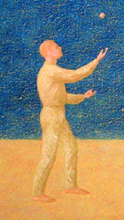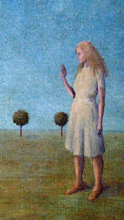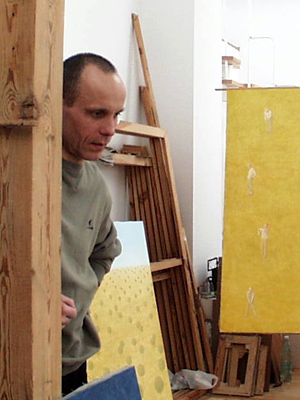I Paint Sweet-and-Sour Pictures
Let's start with the silliest question possible: When did you first realize you would be an artist?
Halfway through my third year in secondary school. Before that I didn't really do any drawing. In primary school I had an unusual, demanding art teacher, who taught us the history of art and it was difficult to get good grades from him, but I sometimes did. And then in the third grade I started drawing in letters to my friend and I remembered that I had used to get good grades from Mr. Adamek and that it had been fun. But why did I decide to be an artist? Many reasons combined: the rebellion of youth, youthful passions, books about artists.
What about talent?
Talent is a suspect word, even though I suppose there is such a thing.
Then there was the Academy. Who did you study under?
First we all studied under Ludwik Maciąg. And then I went to Michał Bylina, I guess mostly because I had friends studying under him. Also, I have always been attracted to realism.
Did you learn anything from Bylina?
Something, yes, but when Bylina retired and Jacek Sienicki came I was relieved at not having to be such an awful realist any longer. Bylina demanded a patriotic kind of realism, for example pictures about Polish-Soviet brotherhood-in-arms. And I did paint some soldiers, it was a really big picture, I remember the boots came out the best. And then the times of Sienicki came, and even though it was already the end of my studies, I owe him a lot. Sometimes I didn't understand all that he said to me, but I really tried hard to do something. He created an atmosphere, and just the contact with him gave me a lot; he was a kind of guru to me. I understood what he said to me in an oversimplistic manner: I tried to paint monochromatically, or rather achromatically: black, white, grey.
And then you started working at the Academy as assistant lecturer.
Yes, I started teaching drawing, because everyone believed I could draw better than I could paint. I believed that too. I stayed at the Academy for twelve years. At first I treated the job as an honour, then routine came, and the last few years I wanted to leave, but I was afraid of being poor. What would I do for a living? Paint? That seemed totally unfeasible. But once I had made the decision, I never regretted it.
And how did the change in your painting come about?
It was a breakthrough. My painting came in for a lot of criticism. I heard that what I did was stiff, lifeless, professional, but in a negative sense: inauthentic. It rattled me quite a bit, because when I started pondering it, I came to the conclusion that the criticism was actually one hundred per cent right. And then it turned out that I couldn't carry on like that any longer! If I was to keep painting, and I wanted to, what should my work be like? I couldn't stop thinking about it. And finally I came to the conclusion that if I did not know how, I must return to nature and just paint the way I see. So I started, but unencumbered by anything. I have my own handwriting, and what I can't do is also something inside me and it has to stay that way. That's how my painting was born. At first there were big pictures, big figures, also because that was the time of "neue Wilde". And then my art started evolving, but there where no breakthroughs anymore. It just went on for some time, until it led to those little humans I paint now. I have often wondered how it came about. I think the reason lies in what I like in art. And at the same time it is a return to what I used to like painting when I was a child.
Looking at your paintings one might say, rather pompously, that you are a painter-philosopher. What would you say to that?
It's hardly beneficial to me to deny, but really I don't feel like a philosopher of any kind, as the word suggests some kind of education in that field, and I have none. What I do springs from two sources: one is simple observation, the other - what I like in art. I observe people in a special way of my own, and if someone believes I see something real in relationships between people, well that's all the better. I think a situation interests me if there's something subtle about it, something delicate, and even better - something equivocal.
And so we have come to the world of the heroes of your paintings. Is your hero's name Everyman?
Generally yes, although more personally speaking, it's me and my wife.
What about the castle that appears so often in your paintings - does it come from Kafka?
Rather not, it is taken directly from my childhood. It's what I used to draw when I was bored during lessons. And the little humans too, by the way. I did not reflect on possible symbolic meanings, even though Freud might have a lot to say. I'm concerned with simple things, with atmosphere; it's enough if it moves someone, intrigues and attracts them.
Are your paintings nice?
When I think about them I call them sweet-and-sour, like Chinese food. The atmosphere is somewhere in between those two elements which together create the climate of the picture, for they're not supposed to be obviously one of those tastes. If you think about paintings by Delaveaux or Magritte you can't say unequivocally whether they are pleasant or not... The most important thing is the suspense, the state of in-between.
I'm glad that you mentioned the surrealists. I think your paintings have a distinct surrealistic atmosphere: the situations your characters find themselves in, the strange activities they have to perform... they are suggestive of Gombrowicz, of the surrealists...
I think my painting may be associated with surrealism partly because of the technical means I use. I don't paint a particular castle, but its approximation or summary. I don't paint a garden, forest or landscape in detail; everything is very conventional, simplified: the sky here, the earth here. There's some symbolism too: people carry eggs on spoons, play games or engage in some kind of absurd competition against one another, like children - and yet they are adults, people manoeuvred into situations which are unnatural for them. You can see the futility of many human efforts here. If you put it all together, it's all a bit empty, a bit surrealistic if you wish, through this emptiness and conventionality. I must emphasize, though, that if I say Delaveaux and Magritte, I mean them specifically; Dali I do not like!.
Let's return for a while to the technical aspects of your paintings. When did little human figures appear in them?
The figures in my paintings shrunk gradually. It was not a fully deliberate or "ideological" step. It's simply that some things are more natural and some less, something turns out better and something worse. I discovered that this scale was the best for me.
Could one say that in your paintings you have come all the way from detailed observation to more and more spacious metaphor?
At the beginning there's always observation of some kind, some specific event. Sometimes I don't even remember it myself. Take for example the picture Chasing birds, which definitely feels like a metaphor of some kind and is supposed to feel like that, and yet it is taken from observation. What's more, it was Bogna and myself who chased birds in fields. The encounter of a real situation and its concept leads to a metaphor. First there's observation, and only later does it lead to generalisation. I suppose it may spring from the ambition to say something that isn't a simple quotation, a copy of reality, but something more sophisticated, deeper...
Is looking for inspiration with existentialist literature in your paintings justified?
No, it isn't, that kind of literature is not very dear to me, I just read other things.
So what are your inspirations?
It's hard to tell, partly because of my incomplete education in the history of early art. There are many names I don't know; apart from that, the names of many artists I like are not known at all, as they belonged to very old times. Anonymous masters, masters of one painting, trecento, quattrocento - those are my favourite painters. Among the known ones I like particularly Piero della Francesca, the Lorenzetti brothers, Sasetta, Giotto, Fra Angelico - but mostly as a painter of altar predellas, as that is my scale. Recently the Italians have gained my complete attention, it is to them that I devote most time in museums. Added to that is my affection for frescoes as a technique, but also as an aesthetic, because they are covered with the patina of many ages. My love for all those faded and worn fragments which I find so attractive makes me want to paint patina in my pictures and achieve an effect similar to and old fresco noticed on the wall of a monastery somewhere in Tuscany. But painting a patina is not really OK, so I don't.
But limiting your palette, avoiding strong colours does produce a kind of patina effect!
I have always liked colours that are toned down. And even though it sounds like some kind of amateur psychology, I don't like anything too strong. It's the same with sounds, music, behaviour. Somebody said that in order to be well understood, one should neither shout nor whisper, but speak in an undertone. That's how my paintings speak, too - in undertones.











